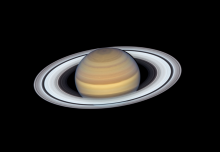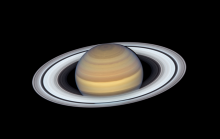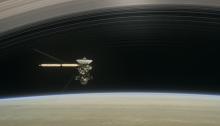Listen to today's episode of StarDate on the web the same day it airs in high-quality streaming audio without any extra ads or announcements. Choose a $8 one-month pass, or listen every day for a year for just $30.
You are here
Moon and Saturn
Every year or two, it seems, there’s a new explanation for the rings of Saturn — how and when they formed. Some researchers have said they formed at about the same time as the planet itself, perhaps from the shattered fragments of a large moon. Others have said they formed much more recently, from the fragments of two moons that rammed together.
And late last year, another group came up with yet another idea: the rings formed about four billion years ago, from a Pluto-sized object that wandered too close to Saturn and was partially pulled apart by Saturn’s gravity.
Saturn’s rings are made mainly of ice, with smaller amounts of rock and dust. And that’s the key to the new idea.
Researchers in Japan simulated encounters between Saturn and objects like Pluto, which should have been plentiful in the early solar system. Their models showed that if one of these objects passed close to Saturn, the planet’s gravity could have sheared off the object’s outer layers, which consisted mainly of ice. Some of this material could then have been captured into orbit around Saturn — enough to account for its rings.
And Saturn is part of a beautiful pairing in the pre-dawn sky tomorrow. The giant planet looks like a fairly bright golden star, quite close to the lower right of the crescent Moon. A telescope will reveal Saturn’s rings — which are beautiful no matter how they formed.
We’ll talk about the Moon and another planet tomorrow.
Script by Damond Benningfield






